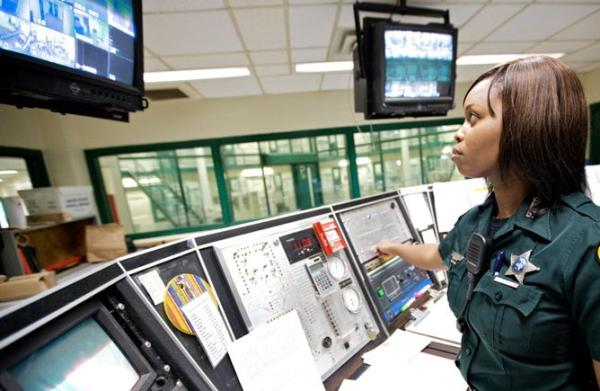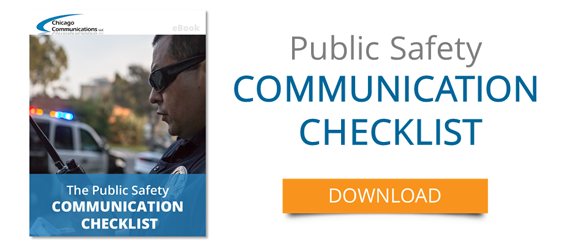How Technology Has Impacted 9-1-1 Dispatch Centers
Over the last thirty years, I have actually counted over 200 radio dispatch consoles that Chicago Communications has installed. A dispatch console is actually an interface for a dispatcher to talk to various radio systems. Similar to a 9-1-1 telephone system, the radio dispatch console acts as an audio switch to connect various people to various radios or telephones.
Thirty years ago the consoles were all hard wired with mechanical switches. A dispatcher that needed to talk to a specific vehicle would press the specific button on his/her console for the radio channel that was needed. This mechanical button would cross connect a set of wires that would allow audio from the dispatcher’s microphone to connect to a radio transmitter (channel) and be broadcasted out. In return, the unit in the field would talk back and the audio from the radio would be passed through the wires to the selected speaker for that position. In its basic form a dispatcher had multiple choices to connect to multiple devices in order to communicate information to the user in the field. Whether a Public Safety call or a call for a Utility or Cab company, the console led flexibility and minimized a dispatcher from having multiple radios to deal with at one location.
 Today’s consoles still operate under the same concept, although technology has led to Software and Computer based systems. Predecessors to today’s computer based systems would fill a whole room with metal bay style furniture. Something you would typically see from Mission Control at NASA, these metal bays would allow cable routing and 19 inch rack mount equipment to be physically installed into the furniture. With the addition of Video, CAD, Statewide computers, village or company owned networks and weather systems, each position would fill a room if metal bay style furniture was used.
Today’s consoles still operate under the same concept, although technology has led to Software and Computer based systems. Predecessors to today’s computer based systems would fill a whole room with metal bay style furniture. Something you would typically see from Mission Control at NASA, these metal bays would allow cable routing and 19 inch rack mount equipment to be physically installed into the furniture. With the addition of Video, CAD, Statewide computers, village or company owned networks and weather systems, each position would fill a room if metal bay style furniture was used.
Instead we now need space for Computer workstations. Each system runs its own specific software and calls for the placement of up to 8 monitors at one position depending on the system being utilized. Backend equipment rooms allow for the guts of the systems to be kept off of the users position. Radio is no longer the single operation that a dispatcher has to be involved with. The typical dispatcher (telecommunicator) now handles multiple systems, multiple calls, processes large amounts of data and generally keeps processes in a managed orderly form.
The radio console in its evolution has not only changed from mechanical wires and switches to software based workstations, but the enhancements, function’s controls and interfaces have changed as well. As networked computer systems, these dispatch consoles can either reside locally on site or be connected as a larger part to regional or statewide systems. From a local level the console still ties radio channels or resources to various dispatchers. Someone’s own internal radio system can be controlled quite effectively. In addition the options for consoles of this type are quite numerous.
The regional dispatch operation on the other hand lends themselves to usually larger systems. In addition, forethought needs to be considered to allow for potential growth to larger solutions.
Objectives to consider when purchasing consoles:
- How many channels of audio are you controlling? Identified as “resources”, these will tell you what size console you need. 4 channel, 8 channel, 12 channel, 24 channel on up.
- How many positions will be required?
- Will you be incorporating telephone?
- Do I need to connect to other regional or statewide systems?
- Will I need to connect via telephone lines or wireless control stations?
- Can I select multiple channels on the radios?
- Are there specific manufacturer related systems that I will need to interface to? This may require specifics that only manufacturer specific consoles will do.
- Who can effectively maintain my consoles and with what response times?
As these are only a few topics there are many considerations in selecting a radio console. Space requirements, cabling, software upgrades, bug fixes, enhancements, recording and screen size are just to name a few more. Look deep into your options. What you need today may not be what you need tomorrow. With consoles lasting typically 5 to 7 years before hardware enhancements are required, insure you are putting your money to good use.
 This article was written by Tom Treichler, Director of Sales & Service at Chicago Communications. Tom has over 30 years of experience in the industry with a background in engineering, system integration, and wireless broadband. If you have any questions for Tom, or another representative at ChiComm, please contact us.
This article was written by Tom Treichler, Director of Sales & Service at Chicago Communications. Tom has over 30 years of experience in the industry with a background in engineering, system integration, and wireless broadband. If you have any questions for Tom, or another representative at ChiComm, please contact us.



